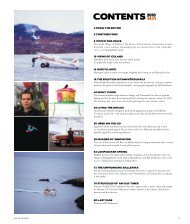Atlantica No. 4, 2010, July-August - Iceland Review
Atlantica No. 4, 2010, July-August - Iceland Review
Atlantica No. 4, 2010, July-August - Iceland Review
- No tags were found...
You also want an ePaper? Increase the reach of your titles
YUMPU automatically turns print PDFs into web optimized ePapers that Google loves.
On the Flytraining, say Benedikt Hjartarson and Árni ThórÁrnason. The former is the first <strong>Iceland</strong>er to swimthe English Channel. Both have been active coldwater swimmers for years and have now starteda company called Coldwater which organizes seaswimming expeditions for visitors. “We know allthe best spots for swimming in the clean Atlantic,so if people want to take a dip they should contactus,” says Hjartarson.Swimming in cold water has multiple healthbenefits according to Hjartarson. “It has very muchbecome part of the health wave as it is consideredgood for the skin, for blood circulation and theimmune system,” he says.In summer the temperature of the sea around<strong>Iceland</strong> is usually about 10°C but in fjords andinlets it can easily reach 15°C. “During winter weoften swim in water down to –2°C. The best timefor practicing for beginners is from mid <strong>July</strong> to theend of <strong>August</strong> when the sea slowly starts coolingdown again,” says Árnason.Stepping into the ice cold water for the first timecan be a challenge even for the strong hearted.Árnason maintains that if a person knows howto swim it is first and foremost a challenge of themind. “When you try this for the first time youhave to remember to control your breathing.There is considerable danger of hyperventilatingand panicking. If you overcome that obstacle andconcentrate on the breathing everything becomeseasier,” he says.But when the limbs go numb, including thearms with which you swim, the danger of drowningbecomes imminent. “There are a few safeguardswe always stress for newcomers. <strong>No</strong> matterhow experienced you are you should never swimalone, you should stay close to the shore and listencarefully to your body,” says Hjartarson.<strong>Iceland</strong>ic cold water swimmers have recentlydiscovered the picturesque rugged lava shorenear Reykjanesvirkjun geothermal power plantwhere hundreds of tons of hot water flow into thesea in a steaming hot river. The stretch of beachis fascinating as <strong>Atlantica</strong> discovered on a visitthere with a group of swimmers recently. Thereare natural hotpots close to the open Atlanticbut the coast is extremely rugged and dangerousfor the inexperienced. “The sea is actually quitewarm out there—it can be up to 30°C—but it ishazardous because of strong currents and waveswhich can smash swimmers into the rocky beachand actually drag them down. I would not dare totake beginners out there,” says Árnason. “There areplenty of other places here where sea swimmingcan be practiced safely according to all securityrules. And when you get into the sport it is anabsolutely fantastic experience.” aOrganized Summer Events forColdwater Swimmers7 <strong>July</strong>: Fossvogur.A 600 and 1,200 meter swim.22 <strong>July</strong>: Bessastadir.Swimmers participate in a swimof 2.2 km or 4.2 km.9 <strong>August</strong>: Fossvogur.A 600 or 1,200 meter swim.14 <strong>August</strong>: Five Islands Swim.Only for experienced coldwater swimmers, 12.5 km.20 <strong>August</strong>: The Videy Swim.Participants swim 900 or 1,800meters. This is probably thelargest sea swimming eventin the country.For more information visitsjosund.is24 atlantica











